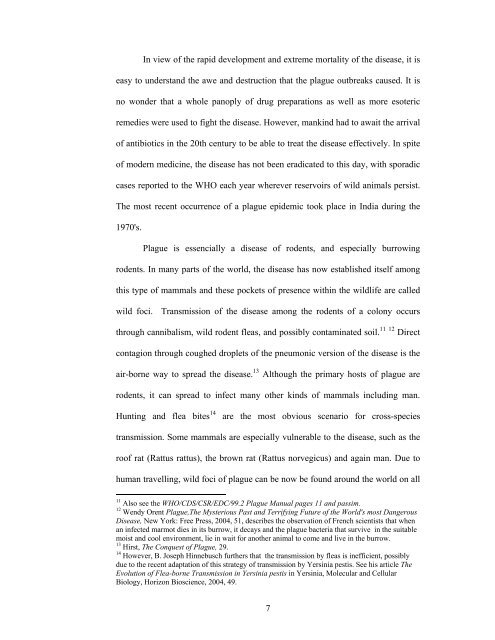the black death in early ottoman territories - Bilkent University
the black death in early ottoman territories - Bilkent University
the black death in early ottoman territories - Bilkent University
You also want an ePaper? Increase the reach of your titles
YUMPU automatically turns print PDFs into web optimized ePapers that Google loves.
In view of <strong>the</strong> rapid development and extreme mortality of <strong>the</strong> disease, it is<br />
easy to understand <strong>the</strong> awe and destruction that <strong>the</strong> plague outbreaks caused. It is<br />
no wonder that a whole panoply of drug preparations as well as more esoteric<br />
remedies were used to fight <strong>the</strong> disease. However, mank<strong>in</strong>d had to await <strong>the</strong> arrival<br />
of antibiotics <strong>in</strong> <strong>the</strong> 20th century to be able to treat <strong>the</strong> disease effectively. In spite<br />
of modern medic<strong>in</strong>e, <strong>the</strong> disease has not been eradicated to this day, with sporadic<br />
cases reported to <strong>the</strong> WHO each year wherever reservoirs of wild animals persist.<br />
The most recent occurrence of a plague epidemic took place <strong>in</strong> India dur<strong>in</strong>g <strong>the</strong><br />
1970's.<br />
Plague is essencially a disease of rodents, and especially burrow<strong>in</strong>g<br />
rodents. In many parts of <strong>the</strong> world, <strong>the</strong> disease has now established itself among<br />
this type of mammals and <strong>the</strong>se pockets of presence with<strong>in</strong> <strong>the</strong> wildlife are called<br />
wild foci. Transmission of <strong>the</strong> disease among <strong>the</strong> rodents of a colony occurs<br />
through cannibalism, wild rodent fleas, and possibly contam<strong>in</strong>ated soil. 11 12 Direct<br />
contagion through coughed droplets of <strong>the</strong> pneumonic version of <strong>the</strong> disease is <strong>the</strong><br />
air-borne way to spread <strong>the</strong> disease. 13 Although <strong>the</strong> primary hosts of plague are<br />
rodents, it can spread to <strong>in</strong>fect many o<strong>the</strong>r k<strong>in</strong>ds of mammals <strong>in</strong>clud<strong>in</strong>g man.<br />
Hunt<strong>in</strong>g and flea bites 14 are <strong>the</strong> most obvious scenario for cross-species<br />
transmission. Some mammals are especially vulnerable to <strong>the</strong> disease, such as <strong>the</strong><br />
roof rat (Rattus rattus), <strong>the</strong> brown rat (Rattus norvegicus) and aga<strong>in</strong> man. Due to<br />
human travell<strong>in</strong>g, wild foci of plague can be now be found around <strong>the</strong> world on all<br />
11 Also see <strong>the</strong> WHO/CDS/CSR/EDC/99.2 Plague Manual pages 11 and passim.<br />
12 Wendy Orent Plague,The Mysterious Past and Terrify<strong>in</strong>g Future of <strong>the</strong> World's most Dangerous<br />
Disease, New York: Free Press, 2004, 51, describes <strong>the</strong> observation of French scientists that when<br />
an <strong>in</strong>fected marmot dies <strong>in</strong> its burrow, it decays and <strong>the</strong> plague bacteria that survive <strong>in</strong> <strong>the</strong> suitable<br />
moist and cool environment, lie <strong>in</strong> wait for ano<strong>the</strong>r animal to come and live <strong>in</strong> <strong>the</strong> burrow.<br />
13 Hirst, The Conquest of Plague, 29.<br />
14 However, B. Joseph H<strong>in</strong>nebusch fur<strong>the</strong>rs that <strong>the</strong> transmission by fleas is <strong>in</strong>efficient, possibly<br />
due to <strong>the</strong> recent adaptation of this strategy of transmission by Yers<strong>in</strong>ia pestis. See his article The<br />
Evolution of Flea-borne Transmission <strong>in</strong> Yers<strong>in</strong>ia pestis <strong>in</strong> Yers<strong>in</strong>ia, Molecular and Cellular<br />
Biology, Horizon Bioscience, 2004, 49.<br />
7
















